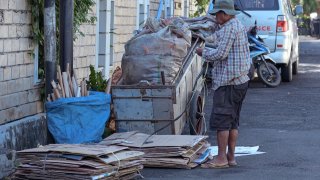
- Last year, the pandemic pushed 4.7 million more people in Southeast Asia into extreme poverty and erased 9.3 million jobs in the region, the Asian Development Bank said in a report published Wednesday.
- ADB expects growth of 5.1% in 2022 as higher vaccination rates prompt economies to reopen, but warns that the new variant could cut growth by as much as 0.8%.
- It urged Southeast Asian governments to invest more in their health-care systems to boost economic growth.
Southeast Asia is grappling with high poverty levels as recurring waves of Covid-19 have dealt a blow to the region's labor market, said the Asian Development Bank.
Last year, the pandemic pushed 4.7 million more people in Southeast Asia into extreme poverty — which is defined as those living on less than $1.90 per day — and erased 9.3 million jobs in the region, the ADB said in a report published on Wednesday.
"The pandemic has led to widespread unemployment, worsening inequality, and rising poverty levels, especially among women, younger workers, and the elderly in Southeast Asia," said ADB President Masatsugu Asakawa.
Get Southern California news, weather forecasts and entertainment stories to your inbox. Sign up for NBC LA newsletters.
Many countries in Southeast Asia have lost their hard-won economic and development gains as they continue to struggle with the spread of the omicron Covid variant.
Though ADB expects growth of 5.1% in 2022 as higher vaccination rates prompt economies to reopen, it warned that the new variant could cut growth by as much as 0.8%.
The countries with the highest number of reported Covid-19 cases in the region since the pandemic began are Vietnam (6.55 million), Indonesia (5.91 million), and Malaysia (3.87 million) — all developing ones — online publication Our World In Data showed.
Money Report
"The pandemic's impact on poverty and unemployment will likely persist as inactive workers become de-skilled and poor people's access to opportunities further deteriorates," ADB said. "When this happens, the deterioration in inequality will transfer across generations."
Signs of recovery in tourism
Despite the volatility the pandemic has created, ADB is optimistic that Southeast Asian economies are beginning to recover.
Southeast Asian countries have mostly been "taking care of their own house" since the Asian financial crisis, and that has put them in a better position to "weather the storm" of the pandemic, said ADB Vice President Ahmed Saeed.
The region, which relies heavily on its tourism industry for growth, expects to see the sector gradually pick up as travel borders begin to open, providing more opportunities for economic growth and jobs.
"Tourism tends to bounce back and to be more robust through the cycle than we expected," Saeed told CNBC's "Squawk Box Asia" on Wednesday.
"Would additional waves of the Covid virus and variants set that back? Yes. But I think ... once the clouds clear ... we will ultimately get back past our 2019 tourism numbers across the region and beyond those," he added.
But Southeast Asia still has a long way to go.
Although overall international tourist arrivals increased by 58% in July to September 2021 compared with the same period in 2020, it remained 64% below 2019 levels, the report stated.
"At present, tourism related goods and services including transport, accommodation, recreation, and other personal services will likely remain weak while travel remains curtailed and social distancing is enforced," ADB said.
Investing in health care
To expedite the region's economic recovery, ADB urged Southeast Asian governments to invest more in their health-care systems.
While the virus could cause long-term damage to economies by causing severe disruptions to supply chains and labor markets, a lack of investment in health care is also worsening inequality, the bank said.
Allocating more resources would "help health systems deliver care, improve disease surveillance, and respond to future pandemics," the bank said.
ADB said Southeast Asia's economic growth could increase by 1.5% if health spending in the region reaches about 5% of gross domestic product, compared with 3% in 2021.
"Countries that had greater internal health care capacity, greater levels of wealth ... managed to come through this process better than" middle- and low-income countries that lack health-care systems and infrastructure, Saeed said.






